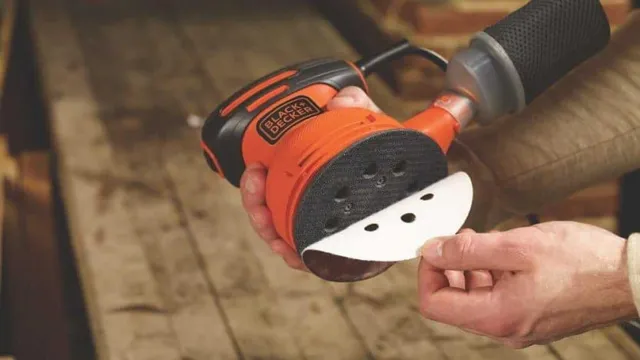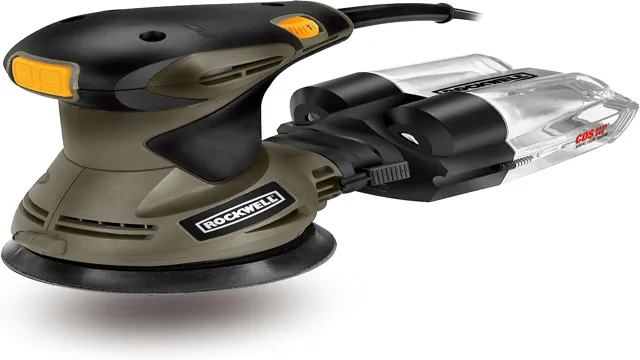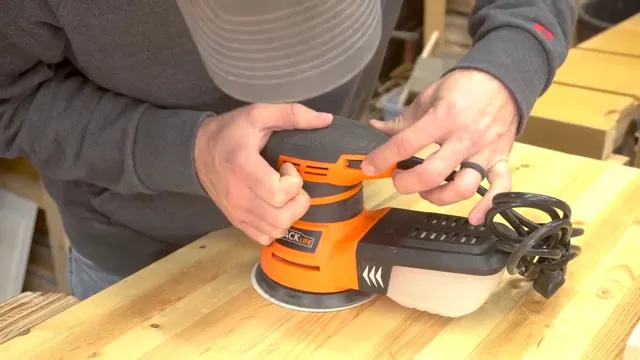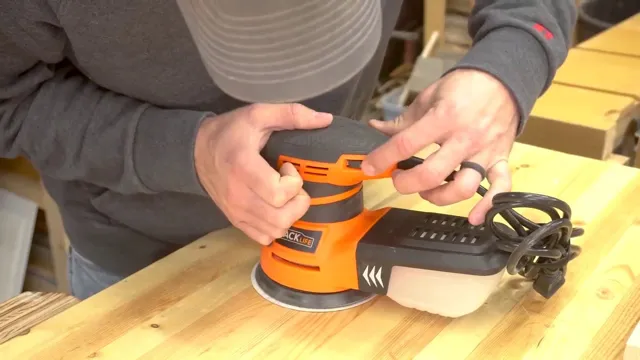How Random Orbital Sander Works: A Comprehensive Guide for DIY Enthusiasts
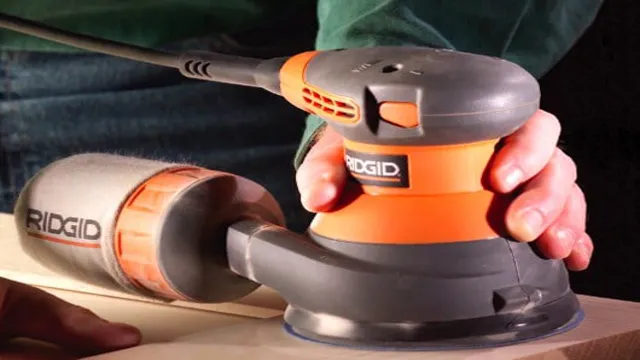
Have you ever wondered how a random orbital sander works? This versatile power tool is essential for any DIY enthusiast or professional woodworker. Unlike a belt sander that moves in a single direction, a random orbital sander rotates and oscillates at the same time, making it less likely to leave sanding marks on the workpiece. The mechanism behind a random orbital sander is based on a circular sanding pad that moves in a random pattern, hence the name.
The pad is attached to a motor that rotates it around its central axis, while at the same time an eccentric bearing moves it back and forth in a random pattern. This dual motion ensures that the sanding pad doesn’t follow the same path twice, guaranteeing a smooth and even finish on any surface. One of the advantages of using a random orbital sander is that it is versatile and can be used to sand a variety of materials, including wood, plastic, and metal.
It is also highly efficient, as the random motion of the sanding pad ensures that the abrasive material on the pad lasts longer, resulting in fewer pad changes. In conclusion, knowing how a random orbital sander works is crucial to achieving professional results in any woodworking project. By understanding the principles behind its operation, users can select the appropriate grit and sanding pad to achieve the desired finish on their workpiece.
So, next time you reach for your random orbital sander, remember that this powerful tool is not just spinning around aimlessly but is working hard to give you the best possible results.
Introduction
If you’re curious about how random orbital sanders work, you’re not alone! These tools are a popular choice for many DIYers and professionals alike for their ability to sand a variety of surfaces efficiently and effectively. Essentially, a random orbital sander features a round pad that spins in random patterns while also vibrating back and forth. This dual-action motion allows the sander to remove material quickly and without leaving swirl marks.
Additionally, the random pattern ensures that the same areas aren’t sanded repeatedly, making it a great choice for finishing work as well. The sander is connected to a power source, typically an electrical outlet or battery, which drives the vibrations and rotation. Overall, a random orbital sander is a versatile and user-friendly tool that can save time and effort on any sanding project.
What is a random orbital sander?
A random orbital sander is a versatile tool used for sanding and polishing surfaces. It is equipped with a circular sanding pad that moves in an elliptical pattern, effectively eliminating swirl marks and creating a smooth surface. Unlike traditional sanders that only move in a circular motion, the random orbital sander moves in different directions, making it less likely to create scratches on the surface.
This tool is ideal for DIY enthusiasts and professionals alike who want to achieve a polished finished on a variety of surfaces such as wood, metal, and plastic. If you’re looking for a tool that can efficiently sand and polish your surfaces without leaving any marks, then the random orbital sander is a great investment.
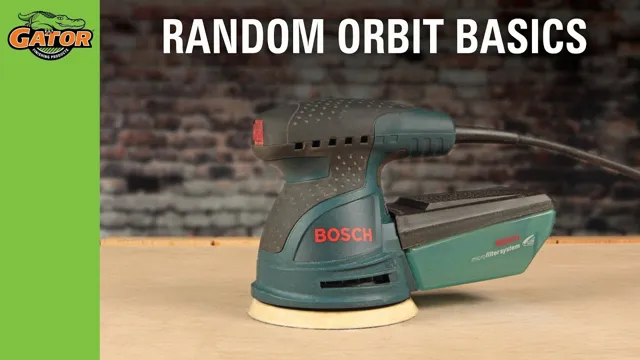
Why use a random orbital sander?
Using a random orbital sander can make sanding tasks significantly easier and produce professional-level results. These sanders are versatile tools that can be used for various sanding needs, including smoothing out rough surfaces and removing old paint. The key advantage of a random orbital sander is its eccentric circular motion, which ensures a consistent and even sanding pattern.
Unlike traditional sanders that move in a straight line, random orbital sanders move in random motions, preventing the creation of scratch patterns on the surface being sanded. Ultimately, using a random orbital sander saves time, reduces effort, and produces a better finishing quality. So, whether you’re a professional contractor or a DIY enthusiast, a random orbital sander is an essential tool to have in your arsenal.
Mechanism of a Random Orbital Sander
If you’re wondering how a random orbital sander works, it’s actually quite simple. Unlike traditional sanders that move in a linear pattern, a random orbital sander moves in a circular motion while also vibrating back and forth. This two-fold action ensures that the sander produces a uniform and smooth finish without leaving behind any swirl marks.
The random motion of the sanding disc is made possible by the evenly spaced offsets in its rotational axis. These offsets cause the sanding pad to rotate and vibrate simultaneously, which reduces the risk of damage to the surface being sanded. The result is a sander that is gentle but effective and ideal for working with wood, metal, plastic, or composite materials.
The key benefits of a random orbital sander are their ability to produce an even finish while also being relatively easy to handle and maneuver, even for beginner DIYers. Overall, a random orbital sander is a valuable tool to have in your arsenal if you want to achieve a professional-looking result with your sanding projects.
Sanding Disc
A sanding disc is an indispensable tool that is used in woodworking for finishing and smoothing down surfaces. When it comes to sanding, one of the most efficient tools that you can utilize is the random orbital sander. This tool features a round sanding pad that spins and moves in random patterns to avoid leaving any noticeable marks on the workpiece.
This mechanism is useful in preventing swirl marks or scratches that can be left behind by other types of sanders. A random orbital sander can be used for various types of surfaces such as wood, plastic, metal, and even automotive parts. The sanding disc comes in different grits, ranging from coarse to fine, and it can be easily changed for different tasks.
The ability to change the disc quickly and easily is a time-saving feature that helps increase productivity. With its unique design, the random orbital sander can provide a smooth and even finish every time, making it the ideal tool for professional woodworkers and DIY enthusiasts alike.
Motor
When it comes to sanding and finishing different surfaces, the random orbital sander is a popular choice among DIY enthusiasts and professionals alike. A crucial component of this tool that makes it stand out from others is its motor. The mechanism of a random orbital sander involves a motor that powers a round sanding disk.
The motor drives the disk in a circular pattern, while also allowing it to move in an elliptical pattern. This combination of motions results in a random sanding pattern that prevents swirl marks on the surface being sanded. The motor operates at high speeds, typically between 6,000 and 22,000 orbits per minute, depending on the model.
With this kind of power, the sander can quickly and effectively remove imperfections from surfaces, making them smooth and ready for finishes such as paint or varnish. Understanding the motor mechanism of a random orbital sander is crucial for getting the best results from the tool and ensuring its longevity.
Counterbalance
Counterbalance A random orbital sander is a power tool that utilizes a circular sanding pad to smooth surfaces with a random orbiting motion. The mechanism of a random orbital sander is based on a counterbalance system that reduces vibration and provides a smooth finish. The counterbalance system incorporates a weight that is attached to the motor and moves in the opposite direction of the sanding pad.
As the pad rotates, the weight moves to counterbalance the vibrations generated by the sanding process. This ensures that the movement of the pad remains stable and reduces the likelihood of gouging or uneven sanding. The counterbalance also helps to extend the life of the sanding pad by reducing wear and tear.
The result is a smoother, cleaner finish that is ideal for a wide range of surfaces, including wood, metal, and plastic. Whether you are a professional woodworker or a DIY enthusiast, a random orbital sander with a counterbalance mechanism is an essential tool to have in your workshop.
Variable Speed Control
Variable Speed Control A random orbital sander is a power tool used to smooth and polish surfaces through the rotation and random movements of its sandpaper disc. A crucial feature that distinguishes it from other sanders is the variable speed control. This function allows users to adjust the speed of the sander according to the task’s requirements.
A lower speed is suitable for delicate finishes, such as polishing, while a higher speed is better for removing rough material, such as paint or rust. With variable speed control, users can fine-tune the sander’s power and ensure a consistent finish across the surface. Notably, the variable speed control is useful in preventing the sander from overheating or causing damage by using excessive force.
It also helps to prolong the lifespan of the sander’s motor and drive system, which can save users money in the long run. In summary, variable speed control is an essential function that gives random orbital sanders versatility and control in achieving the desired results.
Using a Random Orbital Sander
If you’ve never used a random orbital sander before, it may be confusing to understand how it works. Essentially, the sander uses a circular pad that vibrates in a random pattern to sand away material. The random pattern prevents the sander from leaving swirl marks or creating a pattern on the surface being sanded.
One of the benefits of using a random orbital sander is that it is versatile and can be used on a variety of surfaces, from wood to metal. It’s important to choose the right sandpaper grit for the job and to move the sander in a back-and-forth or circular motion, depending on the surface being sanded. With a little practice, using a random orbital sander can give you professional-looking results.
Preparing the surface
Preparing the surface for a project is an essential step that determines the success of the final outcome. Using a random orbital sander is a great way to ensure a smooth and even surface that is free from flaws. This tool is designed to move in a circular motion, which reduces any risk of leaving unsightly sanding marks on the surface of the material.
It is also adjustable, allowing the user to choose the speed and intensity of the sanding action to suit the specific needs of their project. To use the random orbital sander, start by attaching the sandpaper to the tool’s base using the hook-and-loop system. Next, choose the appropriate grit level for the sandpaper, depending on the material you are sanding.
Then, turn on the sander and begin working across the surface, avoiding pressing too hard in one spot, as this can cause uneven sanding. With patience and attention to detail, the random orbital sander can be an invaluable tool for achieving a smooth and professional finish on any surface.
Using the sander
Random Orbital Sander Using a random orbital sander can be a game changer when it comes to tackling surface sanding projects. The first step is to choose the right sandpaper for the job. Generally, the grit you’ll need will depend on the current state of the surface you’re sanding.
A coarser grit, like 80 or 120, may be necessary for removing old paint or heavy weathering. Meanwhile, a finer grit, such as 220 or 240, will be needed for finishing or smoothing out a surface. When it’s time to start sanding, begin with a slow speed and gradually increase until you reach a comfortable level.
While using the sander, make sure to keep it moving in a circular or semi-circular motion to avoid any noticeable swirl marks. It may also be helpful to tilt the sander slightly left and right to effectively blend any overlapping strokes. Always keep both hands on the sander and use it in a controlled manner for the best results.
Changing the sanding disc
Changing the sanding disc on a random orbital sander can sound intimidating, but it’s actually a straightforward process that you can easily do on your own. Firstly, switch off the sander and unplug it from the power source, then unlock the sanding pad by twisting and removing it from the sander’s base. Next, check the new sanding disc to ensure that it is appropriately sized for the sander.
Align the holes of the sanding disc with those on the sander and press the disc onto the sanding pad. Finally, lock the sanding pad back into place by twisting it firmly. That’s it – you’re ready to get back to sanding with your newly changed sanding disc.
Remember to dispose of used sanding discs in an appropriate manner to keep your workspace clean. With this simple process, you can change sanding discs on your random orbital sander with confidence and ease.
Safety Precautions
When operating a random orbital sander, it’s crucial to follow safety precautions to avoid any potential hazards. Firstly, always ensure that the power is switched off and unplugged before attempting any maintenance or blade changes. It’s also essential to wear protective gear such as goggles and earplugs to avoid injury from any flying debris or loud noise.
When using the sander, hold it firmly with both hands and apply even pressure to the surface, avoiding any sudden movements or jerks. Additionally, always keep the sander away from your body, and never touch the sanding pad while it’s in motion or has just been turned off. By following these safety measures, you can enjoy all the benefits of a random orbital sander while minimizing the risk of accidents and injuries.
Wearing eye and ear protection
When it comes to keeping yourself safe while working with loud or potentially hazardous machinery, wearing eye and ear protection should be at the top of your priority list. Eye protection, such as safety glasses or goggles, can prevent harmful debris and chemicals from entering your eyes and causing injury or blindness. Similarly, ear protection, like earplugs or earmuffs, can greatly reduce the risk of noise-induced hearing loss, which can be irreversible.
It may be tempting to skip these safety measures, especially if they seem uncomfortable or inconvenient, but the potential consequences are simply not worth it. Protecting your eyes and ears can help ensure that you can continue to work safely and effectively for years to come. So, if you want to prioritize your long-term health and well-being, make sure to always wear eye and ear protection whenever necessary.
Breathing protection
When it comes to safety precautions on the job, breathing protection should be at the top of everyone’s list. Breathing in hazardous materials can cause serious long-term health effects, such as lung cancer, so it’s crucial to take steps to protect your respiratory system. The best way to do this is by wearing the appropriate breathing protection, such as a respirator or dust mask.
These devices create a seal against your face, filtering out harmful particles from the air you breathe. It’s important to make sure that your breathing protection fits properly, as a poor fit can lead to the inhalation of dangerous materials. Remember, the health risks associated with breathing in hazardous materials are not worth taking.
Protect yourself and your team by investing in high-quality breathing protection.
Avoid loose clothing and tying up long hair
When participating in activities, it is vital to prioritize your safety by avoiding loose clothing and tying up long hair. Loose clothing and long hair can pose a significant danger as they can get caught in machinery or equipment or obstruct your vision, causing accidents. As such, it is crucial to ensure that you wear fitted clothes and tie up your hair to prevent any mishap from occurring.
Loose clothing can also snag on objects or brush against surfaces and cause accidents. Additionally, long hair can obscure your vision, making it challenging to navigate your surroundings, especially when participating in activities like running or cycling. Therefore, it’s essential to prioritize your safety by wearing appropriate clothing and tying up your hair during recreational or athletic activities to reduce the risk of accidents and injuries.
Remember that your safety is paramount, and taking the necessary precautions can prevent accidents and ensure a healthy and enjoyable experience.
Keep the area clean and remove debris
When it comes to ensuring safety in any workspace, it is crucial to keep the area clean and remove debris. This not only prevents potential accidents but also creates a tidier and more organized work environment. Debris left unattended can cause tripping hazards and compromise the integrity of equipment and structures.
To mitigate these risks, it’s important to establish regular cleaning procedures and ensure that all employees are trained on how to maintain a clean workspace. Additionally, it’s important to have adequate storage and disposal systems in place for debris and waste. By prioritizing cleanliness and proper debris management, businesses can ensure the safety and wellbeing of their employees while also promoting productivity and efficiency.
So, take the time to clean up and keep your work area safe and organized!
Conclusion
In conclusion, the random orbital sander is the perfect tool for achieving a smooth and flawless finish on woodworking projects. Its innovative design allows for both random orbiting and oscillating movements, ensuring that each sanding pass is unique and efficient. Simply put, it’s like having a dance partner that knows exactly how to move to the beat of the wood grain.
So, whether you’re a professional woodworker or a DIY enthusiast, the random orbital sander is a must-have tool in your arsenal. Trust us, your woodworking projects will thank you for it!”
FAQs
What is a random orbital sander?
A random orbital sander is a power tool used for sanding wood, metal, or plastic surfaces.
How does a random orbital sander work?
A random orbital sander works by combining orbital and rotary action to produce a random sanding pattern that prevents the sander from leaving swirls or marks.
What is the difference between a random orbital sander and a regular sander?
A regular sander moves in a circular motion, while a random orbital sander moves in a random pattern. This random pattern prevents swirls and marks on the surface being sanded.
What materials can be sanded with a random orbital sander?
A random orbital sander can be used to sand wood, metal, plastic, and even drywall surfaces.
Can a random orbital sander be used for polishing?
Yes, a random orbital sander can be used for polishing surfaces. However, it requires a different attachment or pad than the sanding pad.
What is the benefit of using a random orbital sander over sanding by hand?
Using a random orbital sander allows for faster and more uniform sanding of surfaces, saving time and effort.
What safety measures should be taken when using a random orbital sander?
Safety measures when using a random orbital sander include wearing eye and ear protection, using a dust mask, and securing the workpiece to prevent slipping or moving during sanding.

